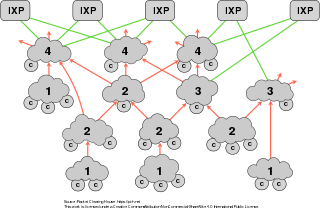In computer networking, peering is a voluntary interconnection of administratively separate Internet networks for the purpose of exchanging traffic between the "down-stream" users of each network. Peering is settlement-free, also known as "bill-and-keep," or "sender keeps all," meaning that neither party pays the other in association with the exchange of traffic; instead, each derives and retains revenue from its own customers.

The Internet backbone may be defined by the principal data routes between large, strategically interconnected computer networks and core routers of the Internet. These data routes are hosted by commercial, government, academic and other high-capacity network centers, as well as the Internet exchange points and network access points, that exchange Internet traffic between the countries, continents, and across the oceans. Internet service providers, often Tier 1 networks, participate in Internet backbone traffic by privately negotiated interconnection agreements, primarily governed by the principle of settlement-free peering.
Traffic shaping is a bandwidth management technique used on computer networks which delays some or all datagrams to bring them into compliance with a desired traffic profile. Traffic shaping is used to optimize or guarantee performance, improve latency, or increase usable bandwidth for some kinds of packets by delaying other kinds. It is often confused with traffic policing, the distinct but related practice of packet dropping and packet marking.
An autonomous system (AS) is a collection of connected Internet Protocol (IP) routing prefixes under the control of one or more network operators on behalf of a single administrative entity or domain, that presents a common and clearly defined routing policy to the Internet. Each AS is assigned an autonomous system number (ASN), for use in Border Gateway Protocol (BGP) routing. Autonomous System Numbers are assigned to Local Internet Registries (LIRs) and end user organizations by their respective Regional Internet Registries (RIRs), which in turn receive blocks of ASNs for reassignment from the Internet Assigned Numbers Authority (IANA). The IANA also maintains a registry of ASNs which are reserved for private use.
Internet exchange points are common grounds of IP networking, allowing participant Internet service providers (ISPs) to exchange data destined for their respective networks. IXPs are generally located at places with preexisting connections to multiple distinct networks, i.e., datacenters, and operate physical infrastructure (switches) to connect their participants. Organizationally, most IXPs are each independent not-for-profit associations of their constituent participating networks. The primary alternative to IXPs is private peering, where ISPs directly connect their networks to each other.
Internet traffic is the flow of data within the entire Internet, or in certain network links of its constituent networks. Common traffic measurements are total volume, in units of multiples of the byte, or as transmission rates in bytes per certain time units.
Bandwidth throttling consists in the limitation of the communication speed of the ingoing (received) data and/or in the limitation of the speed of outgoing (sent) data in a network node or in a network device.

Internet transit is the service of allowing network traffic to cross or "transit" a computer network, usually used to connect a smaller Internet service provider (ISP) to the larger Internet. Technically, it consists of two bundled services:

The Toronto Internet Exchange Community (TorIX) is a not-for-profit Internet Exchange Point (IXP) located in a carrier hotel at 151 Front Street West, Equinix's TR2 data centre at 45 Parliament Street and 905 King Street West in Toronto, Ontario, Canada. As of March 2021, TorIX has 259 unique autonomous systems representing 285 peer connections and peak traffic rates of 1.344 Tbps, making it the largest IXP in Canada. According to Wikipedia's List of Internet Exchange Points by Size, TorIX is the 16th largest IXP in the world in numbers of peers, and 17th in the world in traffic averages. The Exchange is organized and run by industry professionals in voluntary capacity.

Packet Clearing House (PCH) is an international nonprofit organization responsible for providing operational support and security to critical internet infrastructure, including Internet exchange points and the core of the domain name system.

Bill Woodcock is the executive director of Packet Clearing House, the international organization responsible for providing operational support and security to critical Internet infrastructure, including Internet exchange points and the core of the domain name system; the chairman of the Foundation Council of Quad9; the president of WoodyNet; and the CEO of EcoTruc and EcoRace, companies developing electric vehicle technology for work and motorsport. Bill founded one of the earliest Internet service providers, and is best known for his 1989 origination of the anycast routing technique that is now ubiquitous in Internet content distribution networks and the domain name system.
Nepal Internet Exchange is Nepal's only Internet exchange point, established to keep local traffic local and improve local web surfing with local content while saving international bandwidth. It was established in 2002 with the help of Packet Clearing House.

DE-CIX is a carrier- and data-center-neutral internet exchange point (IXP) situated in Frankfurt, Germany. It is the single largest exchange point worldwide in terms of average traffic throughput of 6.9 Tbit/s in April 2021. In addition to DE-CIX in Frankfurt, DE-CIX operates internet exchange points in Düsseldorf, Hamburg, Munich (ALP-IX), New York City, Dallas, Dubai (UAE-IX), Palermo, Marseille, Istanbul, and Mumbai.

The Internet in Africa is limited by a lower penetration rate when compared to the rest of the world. Measurable parameters such as the number of ISP subscriptions, overall number of hosts, IXP-traffic, and overall available bandwidth all indicate that Africa is far behind the "digital divide". Moreover, Africa itself exhibits an inner digital divide, with most Internet activity and infrastructure concentrated in South Africa, Morocco, Egypt as well as smaller economies like Mauritius and Seychelles.
Peer-to-peer caching is a computer network traffic management technology used by Internet Service Providers (ISPs) to accelerate content delivered over peer-to-peer (P2P) networks while reducing related bandwidth costs.
Burstable billing is a method of measuring bandwidth based on peak use. It also allows usage to exceed a specified threshold for brief periods of time without the financial penalty of purchasing a higher committed information rate from an Internet service provider (ISP).
Net bias is the counter-principle to net neutrality, which indicates differentiation or discrimination of price and the quality of content or applications on the Internet by ISPs. Similar terms include data discrimination, digital redlining, and network management.
Grenoble Internet eXchange or GrenoblIX is the Internet eXchange point (IXP) of Grenoble in Isère and Auvergne – Rhône-Alpes region. GrenoblIX allows to the connected members to exchange the traffic in order to avoid passing by faraway infrastructures. This Internet eXchange point is managed by the non-profit organization Rezopole, founded in 2001.
Mumbai Internet Exchange is a Mumbai-based Internet exchange point (IXP) founded in 15 August 2014 as Mumbai Convergence Hub is an Open Carrier Neutral Internet Exchange & Peering Hub. As of 30 March 2021 it interconnects more than 375 members, making it the largest IXP in India and surrounding region.
The Internet Exchange Point Of Nigeria (IXPN) is a neutral and not-for-profit Internet exchange point (IXP) founded in 2006 by the Nigerian Communications Commission(NCC) in partnership with the Internet Service Providers Association Of Nigeria (ISPAN). Among other things, IXPN was created to reduce connectivity costs in millions of dollars in offshore internet bandwidth payments, reduce latency from 900 milliseconds to 30 milliseconds for local content, serve as the central point for connecting Higher Educational Institutions (HEIs) towards the development of National Research and Educational Network (NREN). As at April 2020, IXPN is the 5th largest IXP in Africa by number of peers, and 3rd in Africa by traffic according to Packet Clearing House’s IXP directory







